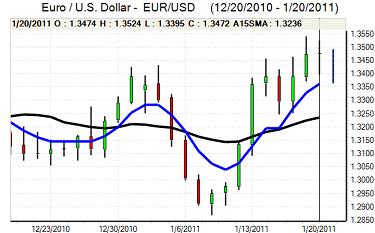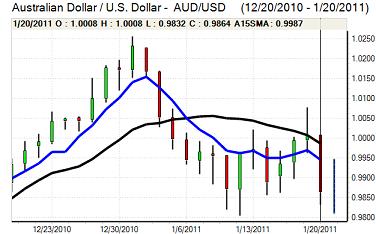EUR/USD
The Euro again hit resistance above 1.3520 against the dollar on Thursday and retreated sharply in New York trading with a brief test of support close to 1.34.
The US economic data was stronger than expected and provided important dollar support as jobless claims dipped sharply to 404,000 in the latest week from 441,000 previously. There was also a sharp rise in existing home sales to an annual rate of 5.28mn from 4.70mn previously while the Philadelphia Fed index held firm at 19.3 for January. The data overall will boost confidence in the US currency and improve yield support.
Ahead of the Federal Reserve meeting next week, there will still be expectations of a sustained ultra-low interest rate policy and the suspicion that the Fed will lag behind other countries will curb dollar support, especially as global yields have also been rising.
The Euro will be in a much stronger position to gain ground if there is a sustained improvement in sentiment towards the structural outlook. For now, there is greater confidence that a crisis can be averted, especially after broadly favourable bond auctions over the past week. There will still be a high degree of unease over the situation, especially with a further round of credit-rating downgrades likely over the next few weeks. Any ECB tightening would also increase unease surrounding the peripheral economies.
The Euro found strong support close to 1.34, especially with reports of further Asian central bank buying and it rallied back to the 1.35 area in Asia on Friday.

Source: VantagePoint Intermarket Analysis Software
Call now and you will be provided with FREE recent forecasts
that are up to 86% accurate * 800-732-5407
If you would rather have the recent forecasts sent to you, please go here
Yen
The dollar found strong support close to 82 against the yen on Thursday and, after a slight rally in European trading, there was a substantial move higher during the US session with the dollar pushing to a high just above 83.
The better than expected US economic data was important in boosting yield support for the US currency and there were further reports of semi-official dollar buying by Japanese institutions.
There was evidence of exporter selling close to the 83 level which slowed the dollar’s advance and there will still be unease over the US fiscal position which will tend to limit buying support. Speculation that further Chinese monetary tightening will be required will also tend to curb selling pressure on the yen.
Sterling
Sterling was unable to break above the 1.60 level against the US dollar during Thursday and was subjected to sharp selling pressure during the US session. There were reports of heavy Euro buying against the UK currency as the Euro rose to the 0.85 level and this was important in pushing Sterling to a low near 1.58 against the dollar.
Sterling had been seen as a safe-haven as Euro-zone fears intensified and there has been some reallocation of funds back to the Euro area as immediate fears have eased.
Domestically, the latest CBI industrial survey was weaker than expected with a decline to -16 for December from -3 previously. As well as weaker order books, the survey also reported rising inflationary pressure which highlights the policy dilemma faced by the Bank of England. Sterling will be vulnerable to selling pressure if there is evidence that the central bank feels that economic weakness will prevent an increase in interest rates.
Sterling did find support close to 1.58 and rallied back to above 1.59 in Asia on Friday as there was a wider dollar reversal.
Swiss franc
The Euro found support close to 1.2850 against the franc on Thursday and rallied to a high above 1.30 during the US session as the dollar also rallied strongly to a high around 0.9680.
An easing of tensions surrounding the Euro-zone has triggered a partial reversal of defensive capital flows into the Swiss franc and franc demand will remain weaker if confidence in the Euro improves, but there will still be the risk of a rapid reversal.
National Bank Head Hildebrand stated that franc strength was hurting exports and the recovery. Nevertheless, he also stated that deflation threat had disappeared which suggests that the bank will not have a mandate to intervene and weaken the Swiss currency.

Source: VantagePoint Intermarket Analysis Software
Call now and you will be provided with FREE recent forecasts
that are up to 86% accurate * 800-732-5407
If you would rather have the recent forecasts sent to you, please go here
Australian dollar
The Australian dollar hit resistance above 0.9950 against the US dollar on Thursday and retreated sharply during the US session with lows near 0.9825 before a limited recovery.
The Australian dollar was undermined initially by a firmer US currency and there were also fears of further monetary tightening by the Chinese central bank. Gold prices were generally weaker which sapped demand for the Australian currency and there were wider doubts over the domestic economy. Selling pressure was alleviated by a general recovery in risk appetite.



